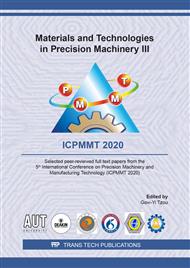p.1
p.12
p.21
p.27
p.33
p.41
p.48
p.56
Design and Manufacturing of Knee Implants for Osteoarthritis Patients
Abstract:
Knee osteoarthritis is one of the major causes of musculoskeletal impairment in adults. This disease is mainly characterised by progressive degeneration of the articular cartilage, and to date, there is no known cure for it. Initiation and progression of the osteoarthritis pathology is associated with knee loading conditions. For younger, active patients with knee osteoarthritis, common treatments include non-invasive options in order to manage symptoms before considering, as a last resort, the surgical options, in particular the gold standard treatment: knee replacement. The advent of orthopedic prostheses for knee replacement and their widespread applications have helped millions of patients worldwide to be relieved from pain and gain their mobility. However, they are still not suitable for young or middle-aged patients suffering from localised cartilage damage, due to the limited life span of these load-bearing devices. All available remedies for those patients are temporary and some of them might result in regeneration of tissues with different properties to the existing one, and hence limited functionality and durability. In this paper, different types of implants developed and tested at Auckland University of Technology for younger patients with osteoarthritis will be presented and discussed. Recently developed load-sharing implants could be considered as suitable options lying between the symptom management and invasive treatments. One such implant is comprised of femoral and tibial components, and removes excessive load through the knee joint by attachment to the medial side. Another developed implant prevents further tissue degeneration through replacing damaged regions of the tissue and preserving the remaining healthy portion. This results in prolonging the tissue functionality, and further postponing the total joint replacement. These patient-specific implants would be suitable for early-onset knee osteoarthritis and can be used for younger active patients, as no major modification in the knee joint is required.
Info:
Periodical:
Pages:
1-11
Citation:
Online since:
October 2020
Authors:
Keywords:
Price:
Сopyright:
© 2020 Trans Tech Publications Ltd. All Rights Reserved
Share:
Citation:


